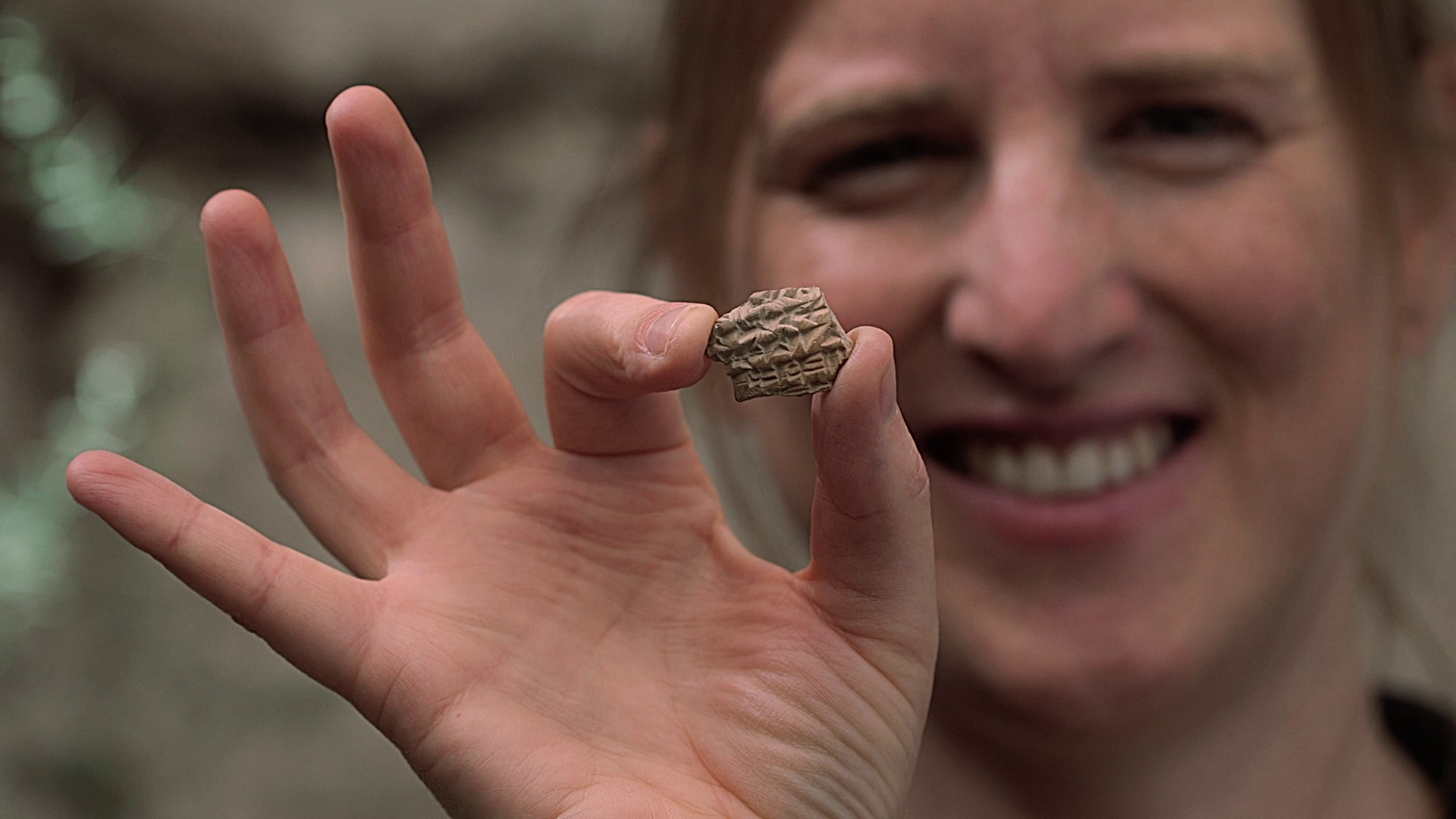A tiny, extremely rare pottery sherd bearing a cuneiform inscription in the Akkadian language from about 2,700 years ago was discovered in an archaeological excavation near the Western Wall of the Temple Mount, north of the City of David. This is an extraordinary find and the first of its kind – the only Assyrian inscription from the First Temple period (8th to 7th centuries BCE) ever found in the city.
The inscription will be presented to the public for the first time this Thursday, October 23, at the New Discoveries in Jerusalem and Environs Conference by the Israel Antiquities Authority, the Hebrew University of Jerusalem, and Tel Aviv University, at the Jay and Jeanie Schottenstein National Campus for the Archaeology of the Land of Israel
The rare discovery was uncovered as part of an Israel Antiquities Authority archaeological excavation, in collaboration with the City of David Foundation and directed by Dr. Ayala Zilberstein of the Israel Antiquities Authority. The excavation is taking place in Jerusalem’s Davidson Archaeological Park, which is managed by the Company for the Reconstruction and Development of the Jewish Quarter. The rare inscription was deciphered in collaboration with Dr. Filip Vukosavović and Dr. Anat Cohen-Weinberger of the Israel Antiquities Authority, together with Dr. Peter Zilberg of Bar-Ilan University.
The tiny fragment, about 2.5 cm in size, was discovered thanks to the wet sifting process conducted by the “Archaeological Experience” in the Emek Tzurim National Park – a joint project of the Israel Nature and Parks Authority and the City of David Foundation. The discovery of this unique find of such historical import in an organized scientific archaeological excavation – in other words, ensuring its authenticity with no chance of a forgery, as is always the possibility of finds surfacing on the antiquities market – was accompanied by great excitement.
Moriah Cohen, who works at the “Archaeological Experience” in Emek Tzurim, described the moments of the discovery. “I was sifting through the dirt and suddenly noticed a sherd with a strange decoration. Examining it closely, it looked to me to be cuneiform, but that seemed totally unreasonable. Even though so many fascinating finds have been discovered here over the years, we’ve never, ever found anything like this. I examined it yet again. After decidedly determining that this was no decoration, but really was cuneiform, I screamed out of excitement. Everyone raced to gather around me and I phoned Ayala, the excavation director, who was thrilled. For me personally, the thought that after 2,700 years, I am the first person to actually touch this pottery with my hands is a very exciting thought. This is a once-in-a-lifetime find.”
The unique piece was discovered in dirt that had been swept to the edge of the city’s central drainage canal, dating from the Second Temple period about 2000 years ago. Likely, this accumulation belonged to the collapse of an earlier First Temple period structure, discovered in an area where the later drainage canal was not preserved, thus enabling access to the earlier layer.
Located on the eastern slope of Jerusalem’s Western Hill, this site is among the closest places west of the Temple complex where remains from the First Temple period have been found in their original context, a fact that gives the find great importance for understanding the urban and political development of the period.
According to Dr. Ayala Zilberstein, Excavation Director on behalf of the Israel Antiquities Authority, “The inscription provides direct evidence of official correspondence between the Assyrian Empire and the Kingdom of Judah. The discovery strengthens our understanding of the depth of the Assyrian presence in Jerusalem, and the extent of its influence on and involvement in the conduct of the affairs of the Judean kingdom. In addition, it expands knowledge about the status of the new neighborhood that developed at that time on the slopes of the hill to the west of the Temple. It appears that this area served as a focus for the activities of high-ranking ministers and persons.”
Dr. Peter Zilberg and Dr. Filip Vukosavović believe that the fragment of the inscription was part of an inscribed royal sealing – a seal impression intended to seal a letter or an official dispatch on behalf of the Assyrian royal court. “Bullae or sealings of this type bore an impression that was sometimes accompanied by a short inscription in Assyrian cuneiform script noting the dispatch’s contents or its destination. These differ in size and shape from the local Judahite impressions,” the Assyriologists explain.
Analysis of the inscription fragment and its content reinforces the hypothesis that the sealed document deals with a delay in paying a tax, or another obligation. The inscription specifies a due date – the first of the month of Av, in a calendar shared between Mesopotamia and Judah. Furthermore, it explicitly
mentions a chariot officer, the “one who holds the reins”, in Assyrian terms. This title indicates a high-ranking personality, responsible for conveying official messages on behalf of the royal house. Such a figure is indeed well-known from Assyrian administration archives.
Though the inscription fragment does not explicitly mention the name of the king of Judah to whom the shipment was intended, its chronological context and the partial text allow us to assume that it was sent to the court of either King Hezekiah, Manasseh, or early in Josiah’s reign, during which Judah was a vassal kingdom of Assyria. Items of this type would serve as a means of communication between the envoys of the Assyrian government and the rulers of Judah, conveying official instructions and tax demands.
“While we cannot determine the background for this demand, whether it stemmed from a mere technical delay or was taken as a deliberate step with political significance, the very existence of such an official appeal would seemingly attest to a certain point of friction between Judah and the imperial government,” say the researchers. One of the directions of research being examined is that the royal seal impression was sent to Judah during the time of Sennacherib, king of Assyria. This suggestion notes the characteristics of the inscription, and its dating to the reign of this very king or one of his descendants, perhaps echoes a story of a tax revolt, such as the biblical description of Hezekiah’s revolt against Sennacherib, recounted in Kings II (18:7), “And he rebelled against the king of Assyria, and did not serve him.”
A petrographic analysis of the bulla indicated that it was not produced in Jerusalem, but was sent here from far away, most likely from one of the administrative centers of Assyria, such as Nineveh, Ashur, or Nimrud/Kalḫu.
According to Dr. Anat Cohen-Weinberger of the Israel Antiquities Authority, “Petrographic analysis of the fragment’s composition revealed that the material from which it was made is entirely different from the local raw materials typically used to produce pottery, bullae, and clay documents in Jerusalem and the southern Levant. Moreover, the bulla’s mineral composition generally corresponds to the geology of the Tigris Basin region, where the central cities of the Assyrian kingdom were located, such as Nineveh, Ashur, or Nimrud/Kalḫu. A chemical analysis of the bulla’s composition is currently being conducted in collaboration with Dr. Yehudit Harlavan of the Geological Survey of Israel, to precisely determine its provenance.”
The Assyriologists add, “This is a small fragment of great significance. The find opens a window into understanding the political and administrative ties between Judah and Assyria. It is the very first evidence of its kind of the official, and perhaps even tense, communication that took place between Jerusalem and the world’s most powerful superpower during the period we are discussing.”
Israeli Minister of Heritage, Rabbi Amichai Eliyahu, says, “The discovery of the Assyrian inscription from the First Temple period in the very heart of Jerusalem is impressive evidence of the city’s status as the capital of the Kingdom of Judah some 2,700 years ago, and of the depth of its ties with the Assyrian Empire just as described in the Bible. This rare discovery illustrates, once again, our deep roots in Jerusalem, which is the spiritual and national center of the Jewish people.”





